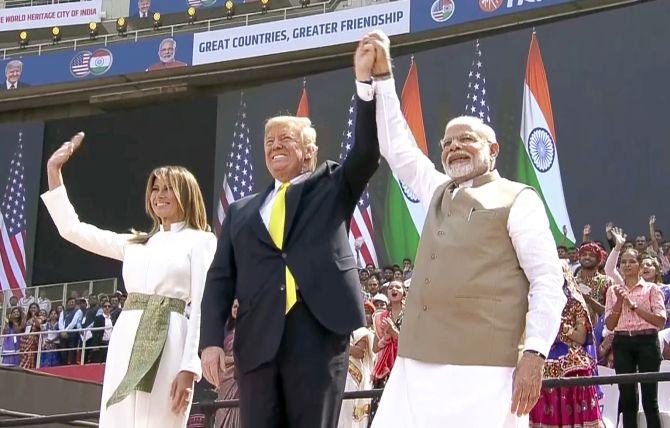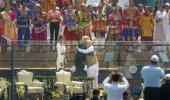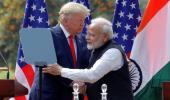Trump's visit symbolised heightened partisanship and a return to chemistry between leaders defining bilateral ties, notes Kashish Parpiani.

US President Donald Trump's 36-hour visit was originally set to witness a limited US-India trade deal, amidst the crescendoing (external link) of tensions on the trade front.
Ahead of the visit however, negotiations hit a stalemate due to both sides alleging either party of 'changing goalposts', such as the last-minute American insistence of India increasing import of products like pecan nuts. Hence, the Modi government began to tout the 'Namaste Trump' event as the 'key deliverable' of the visit.
Although the relevance of the event stood accentuated by the wall-to-wall coverage it received in the media -- albeit mainly from the standpoint of optics -- it signified an untoward trend.
Over the past year, there have been rising concerns (external link) over US bipartisan support on India fraying.
Certainly, in large parts, that has been so due to the rabid polarisation now seeping into the once iron-clad US bipartisan consensus on most aspects of American international relations.
However, on India specifically, that schism has emerged also due to the apparent partisan fervour of the 'Howdy, Modi!' rally and the Democrats's rising apprehensions (external link) on the communications lockdown in Kashmir.
With this visit, it was apparent that the Trump administration also has a partisan approach to India.
At the 'Namaste Trump' event, for instance, President Trump built on his September 2019 praise of Prime Minster Modi as the 'Father of India'.
In Ahmedabad, Trump began his address by describing his host as 'an exceptional leader, a great champion of India, a man who works night and day for his country, and a man I am proud to call my true friend'.
Trump didn't stop there, and went on to echo many points that may generally be heard at a BJP election rally.
He added, 'Under Prime Minister Modi, for the first time in history, every village in India now has access to electricity. Three hundred and twenty million people -- more Indians -- are right now connected to the Internet. The pace of highway construction has more than doubled.'
He went on to also cite figures on households having access to cooking fuel and basic sanitation.
At a follow-up press conference, Trump refused to comment on the controversial citizenship law: 'I don't want to discuss that, I want to leave that to India.'
All was not lost to partisanship as the second day of the visit saw some policy gains.
In exchange for the limited trade deal, India's expectation had been to oversee its GSP beneficiary status reinstated.
To recap: In the recent past, trade tensions escalated owing to the US adopting punitive measures.
Beginning with levying steel and aluminum tariffs on India in mid-2019, the Trump administration revoked India's beneficiary status under the Generalised System of Preferences programme under which exports worth $5.7 billion to the US enjoyed duty-free status in 2017.
However, ahead of the visit, the US pre-emptively closed the door to restoration of India's GSP benefits.
A few days after Trump's visit was announced, the US trade representative released a federal notice on removing countries like India from its list of developing countries that 'are exempt from investigations into whether they harm American industry with unfairly subsidised exports.'
This effectively rendered India to be classified as a developed country, and thus no longer eligible for benefits under the GSP, which is a preferential arrangement for developing countries alone.
With a limited trade deal off the table, the visit's policy gains seemed restricted to impending defence deals.
The two sides announced the finalisation of a defence package worth over $3 billion for 24 multi-role MH-60R Seahawk maritime helicopters and six AH-64E Apache attack helicopters.
However, there was no word on India finalising the recently cleared $1.867 billion Integrated Air Defence Weapon System, which would possibly help in tempering US apprehensions on India also purchasing the Russian S-400 missile system (external link).
The fact that the two sides managed to formalise cooperation on latent avenues like clean energy signified a certain sense of compartmentalisation to have been instituted, unarguably a rare feat under Trump's conduct of US foreign policy, in the US-India bilateral dynamic.
However, despite the emergence of this mature understanding, the visit bore another untoward development -- potentially reversing the trend on the gradual institutionalisation of US-India ties.
Ahead of Trump's visit, an unnamed high-level source in the Indian government characterised the visit as: "Forget about mathematics or trade or defence. Talk chemistry! Chemistry ab badhega!" (Essentially translating to, an increase in chemistry between the leaders will be a key outcome.)
Aside from any increase in that unquantifiable facet of bilateral ties, 'chemistry' between President Trump and Prime Minister Modi was, however, deemed to be a key catalyst of an expected resolution to the current impasse on trade.
At their joint appearance in Ahmedabad, Trump expressed his optimism over 'the Prime Minister and I working together towards reaching a fantastic deal that's good and even great for both of our countries.'/p>
He jokingly even added a caveat: 'Except that he's (Modi) a very tough negotiator.'
Whereas, over the past couple of years, the effort has been to move away from the traditional top-heavy approach of relying on chemistry between the heads of State to inform the US-India bilateral trajectory.
In the past, that approach was particularly efficacious in wading through 'conflictual points such as the US opposition to India's nuclear programme' (external link).
However, as US-India ties have assumed a multi-dimensional character -- bereft of a comprehensive trade arrangement or a formal security treaty underpinning the partnership, the trajectory has warranted champions (external link) of greater ties on multiple levels of either nation's political, bureaucratic and military leadership.
Nascent examples of such institutionalised channels include the US-India 2+2 annual consultative platform (external link) between foreign and defense portfolio chiefs, the India-US Strategic Energy Partnership working group between India's petroleum minister and the US energy secretary, and the hotline instituted between Indian and American national Sscurity advisors.
With the recent visit once again according chemistry between the two leaders's central relevance -- this time in context of the stalled trade negotiations, it seems the bilateral trajectory is returning to the era of seeking high-level interventions.
Thus, despite some gains on the policy level, Trump's visit to India symbolised heightened partisanship and a return to chemistry between leaders defining bilateral ties.
Kashish Parpiani is a Research Fellow, Observer Research Foundation.











 © 2025
© 2025